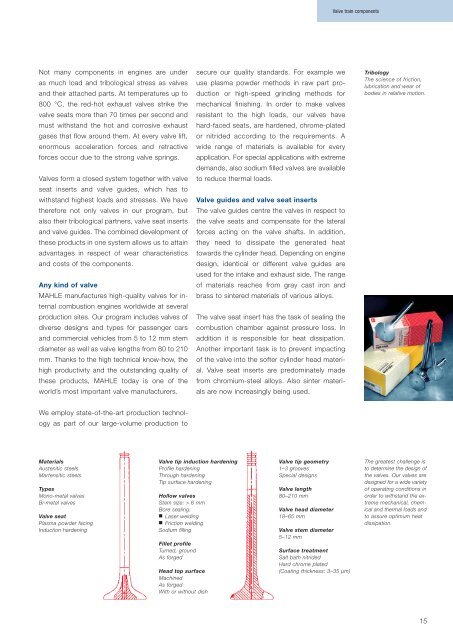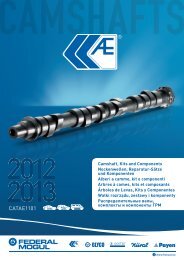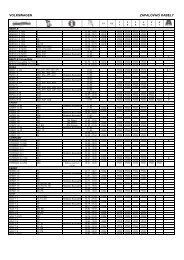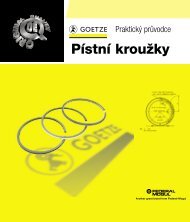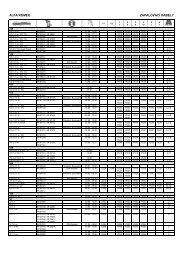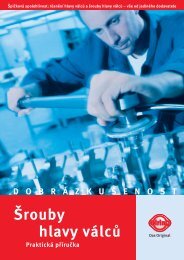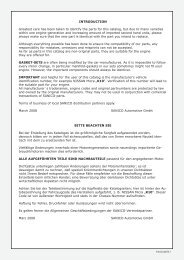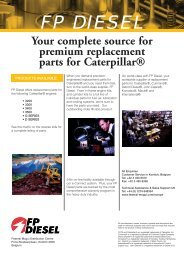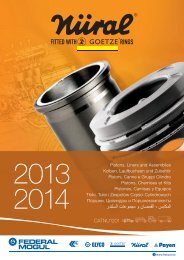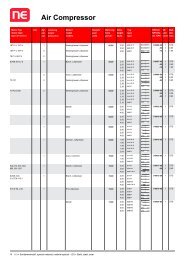You also want an ePaper? Increase the reach of your titles
YUMPU automatically turns print PDFs into web optimized ePapers that Google loves.
Valve train components<br />
Not many components in engines are under<br />
as much load and tribological stress as valves<br />
and their attached parts. At temperatures up to<br />
800 °C, the red-hot exhaust valves strike the<br />
valve seats more than 70 times per second and<br />
must withstand the hot and corrosive exhaust<br />
gases that flow around them. At every valve lift,<br />
enormous acceleration forces and retractive<br />
forces occur due to the strong valve springs.<br />
Valves form a closed system together with valve<br />
seat inserts and valve guides, which has to<br />
withstand highest loads and stresses. We have<br />
there fore not only valves in our program, but<br />
also their tribological partners, valve seat inserts<br />
and valve guides. The combined development of<br />
these products in one system allows us to attain<br />
advantages in respect of wear characteristics<br />
and costs of the components.<br />
Any kind of valve<br />
<strong>MAHLE</strong> manufactures high-quality valves for in -<br />
ter nal combustion engines worldwide at several<br />
production sites. Our program includes valves of<br />
diverse designs and types for passenger cars<br />
and commercial vehicles from 5 to 12 mm stem<br />
diam eter as well as valve lengths from 80 to 210<br />
mm. Thanks to the high technical know-how, the<br />
high productivity and the outstanding quality of<br />
these products, <strong>MAHLE</strong> today is one of the<br />
world’s most important valve manufacturers.<br />
secure our quality standards. For example we<br />
use plasma powder methods in raw part production<br />
or high-speed grinding methods for<br />
mechanical finishing. In order to make valves<br />
resistant to the high loads, our valves have<br />
hard-faced seats, are hardened, chrome-plated<br />
or nitrided according to the requirements. A<br />
wide range of materials is available for every<br />
application. For special applications with extreme<br />
de mands, also sodium filled valves are available<br />
to reduce thermal loads.<br />
Valve guides and valve seat inserts<br />
The valve guides centre the valves in respect to<br />
the valve seats and compensate for the lateral<br />
forces acting on the valve shafts. In addition,<br />
they need to dissipate the generated heat<br />
towards the cylinder head. Depending on engine<br />
design, identical or different valve guides are<br />
used for the intake and exhaust side. The range<br />
of materials reaches from gray cast iron and<br />
brass to sintered materials of various alloys.<br />
The valve seat insert has the task of sealing the<br />
combustion chamber against pressure loss. In<br />
addition it is responsible for heat dissipation.<br />
Another important task is to prevent impacting<br />
of the valve into the softer cylinder head material.<br />
Valve seat inserts are predominately made<br />
from chromium-steel alloys. Also sinter materials<br />
are now increasingly being used.<br />
Tribology<br />
The science of friction,<br />
lubrication and wear of<br />
bodies in relative motion.<br />
We employ state-of-the-art production technol -<br />
ogy as part of our large-volume production to<br />
Materials<br />
Austenitic steels<br />
Martensitic steels<br />
Types<br />
Mono-metal valves<br />
Bi-metal valves<br />
Valve seat<br />
Plasma powder facing<br />
Induction hardening<br />
Valve tip induction hardening<br />
Profile hardening<br />
Through hardening<br />
Tip surface hardening<br />
Hollow valves<br />
Stem size: > 6 mm<br />
Bore sealing:<br />
■ Laser welding<br />
■ Friction welding<br />
Sodium filling<br />
Fillet profile<br />
Turned, ground<br />
As forged<br />
Head top surface<br />
Machined<br />
As forged<br />
With or without dish<br />
Valve tip geometry<br />
1–3 grooves<br />
Special designs<br />
Valve length<br />
80–210 mm<br />
Valve head diameter<br />
18–65 mm<br />
Valve stem diameter<br />
5–12 mm<br />
Surface treatment<br />
Salt bath nitrided<br />
Hard chrome plated<br />
(Coating thickness: 3–35 μm)<br />
The greatest challenge is<br />
to determine the design of<br />
the valves. Our valves are<br />
designed for a wide variety<br />
of operating conditions in<br />
order to withstand the extreme<br />
mechanical, chemical<br />
and thermal loads and<br />
to assure optimum heat<br />
dissipation.<br />
15


